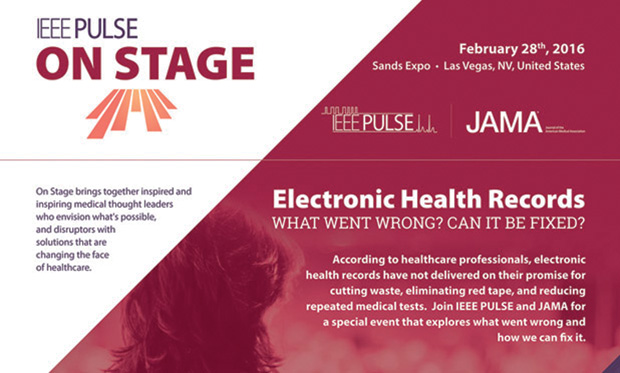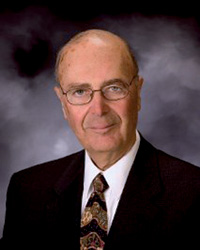As we look back over 2016 at IEEE Pulse, we can proudly say that our efforts to bring you up-to-date and informative articles that span the EMB spectrum have paid off. IEEE Pulse began the year with a comprehensive look at what’s new in wearables, including an on-point profile of John Rogers and his work with ultrathin sensors. In February, the first IEEE Pulse On Stage event was held in collaboration with the Journal of the American Medical Association (JAMA) during the 2016 HIMSS conference in Las Vegas, Nevada, bringing together health care leaders and innovators to discuss the challenges and promise of the electronic medical record (Figure 1).

Our issue on synthetic biology (March/ April) highlighted a conversation with early field pioneer Tom Knight, along with articles on cell-free biology, organs- on-chips, and the complex potential of the CRISPR gene-editing tool. The rehabilitation technology issue (May/June) explored more recent accomplishments in engineering prostheses, orthotics, and bionics, while also revisiting the value of simple technology that has the power to change lives, like the Jaipur foot, as well as new research in technology to help manage essential tremor and low vision.
Research into how the brain functions has become a top priority, as evidenced by the work of MacArthur Fellowship awardee Danielle Bassett, who is taking a systems-level approach to understanding how different brain areas communicate. Stem-cell research has also gained momentum with the promise of discovering new approaches to disease, as well as the possibilities for tissue sourcing and drug testing using organoids, as seen in our July/August issue.
The microbiome issue (September/October) probed new research in this previously overlooked environment, examining its potential for harnessing new antibiotics as well as its role in health and disease. We also took a closer look at big data and health and investigated ways that data might best be leveraged to provide meaningful insights. On our website this year, we showcased articles as diverse as the work of the The Foundry at the Massachusetts Institute of Technology, cybersecurity for health care, and the potential impact of the Brexit vote on scientific research in the United Kingdom.
This last issue of the year takes a look at rural health care, beginning with an overview of the challenges to improving rural care from the Brookings Institution and articles on mHealth, technological innovations, women’s health, and programs targeting diseases such as malaria and tuberculosis. We also feature an interview with Affectiva CEO and cofounder Rana el Kaliouby on the company’s mission to “bring emotional intelligence to the digital world.”
Some of the year’s favorite articles chosen by staff and not previously mentioned include “The Problem of False Discovery” (March/April), “Electrical Stimulation: A Panacea for Disease?” (May/June), “The Precise—and Wild—Genomics Revolution” (September/October), and “New Frontiers in Robotic Surgery” (November/ December). And although we cannot mention every article here, we would like to thank the researchers and writers who have contributed to IEEE Pulse over the year. It is because of your work that we are able to share so many fascinating new ideas.

This year’s review would not be complete without remembering our dear friend and colleague, Michael R. Neuman, M.D., Ph.D., who passed away on 18 February (right). Michael was an intelligent and hardworking engineer and innovator as well as an amazing mentor, and it was under his guidance that IEEE Pulse was born. As editor-in-chief, Michael envisioned a new kind of magazine for the Society and was instrumental in transforming what had been a marginal periodical into the active, multidimensional publication you see today. As associate editor, I had the privilege of working with Michael for nearly seven years and enjoyed all of our conversations and planning sessions over that time (see also the remembrance below from Max E. Valentinuzzi). He is greatly missed, but his smile and laughter, boundless energy, and good humor will always be remembered.
— Cynthia Weber
Michael R. Neuman
Friends do not necessarily have to talk and see each other every day; they do not even need to do it for a long time. However, when similar dreams, aims, and ideals link them, fruitful outcomes come easily.
So much has been said and written about friendship, in simple sentences, poems, and songs, that almost nothing else remains to add. Besides, the relatively recent technological communications boom has created perhaps a new approach and new avenues—bringing people together across the miles.
Sadly, Mike is not with us anymore, and in these circumstances, maybe I should recall what he did, which was a lot. No need, however, to do this—for we can easily find plenty of information on our Almighty Web. I simply want to muse about my friend, whom I personally saw for the last time in Buenos Aires City in 2010 during one of the IEEE Engineering in Medicine and Biology Society conferences. Tasting a cup of coffee, kindly smiling, he (as editor-in-chief) offered me the opportunity to oversee the “Retrospectroscope” column of the newly reshaped IEEE Pulse magazine [1].
When did we meet? Oh, I cannot remember, but it was many, many years ago (we both surpassed a half century as IEEE Members). We’d see each other most times during conferences, sharing ideas and starting some project that thereafter was better shaped via e-mail (or sometimes quietly faded out), and also as members of a committee … yes, memories flood me as an endless fresh waterfall. Always within a joyful and intimate atmosphere, sprinkled with good humor and keen comments, understanding each other quickly, as Seneca the Younger stated very early in the Christian Era. In 2012, I helped him with a multiauthor review article that had been itching at and worrying him for some time [2]. Later, after he left the editor-in-chief position with IEEE Pulse, he cheerfully sent me a message of encouragement to collect the five-year history of published columns (2011–2015) into a single book. This was his salient characteristic: encouragement to do things, pushing students and collaborators ahead.
His rather recent words say, “Welcome to the October 2014 issue of the IEEE Life Sciences Newsletter. By way of introduction, I am Michael Neuman, the newly appointed editor-in-chief of the newsletter. I am a professor of biomedical engineering at Michigan Technological University in Houghton, in Michigan’s beautiful Upper Peninsula. I also am involved in health care leadership as the chair of the Board of Trustees at our local hospital, Portage Hospital.” Clear, straight, leaving no doubts.
I will miss and remember you Mike. As a poet once wrote, “not dead, just gone before.”
References
- M. E. Valentinuzzi, “Why study the history of BME , science, and technology?” IEEE Pulse, vol. 2, no. 1, pp. 45–47, Jan./Feb. 2011.
- M. R. Neuman, G. D. Baura, S. Meldrum, O. Soykan, M. E. Valentinuzzi, R. S. Leder, S. Micera, and Y.-T. Zhang, “Advances in medical devices and medical electronics,” Proc. IEEE, vol. 100 (centennial issue), pp. 1537–1550, 2012.


